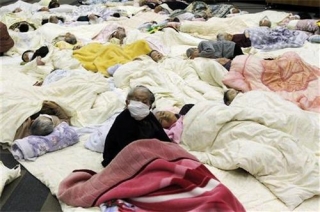This is one of a series of articles being produced by Aberdeen and District Campaign for Nuclear Disarmament (CND). You can read further articles in both past and future editions of Aberdeen Voice. With thanks to Jonathan Russell.
Even a nuclear power plant that suffers accidental damage has dire long-term consequences, for instance those following Fukushima’s nuclear disaster and although the first reports suggested that harvests contained levels of contamination well under the safety limit for human consumption:
- more recent research by the Universities Space Research association in the US State of Maryland has found that the area of eastern Fukushima had levels that exceeded official government limits for arable land and
- researchers estimated that cesium-137 (the longest lasting contaminant) found close to the nuclear plant was eight times the safety limit, while neighbouring regions were just under this level.
Much more worryingly, there is a daily struggle to keep 1,500 rods cool which, otherwise, would release huge amounts of radiation into the atmosphere.
If hit by another similar earthquake, the US National Council on radiation protection, along with Japanese experts, have stated that if there were another earthquake, there is a 70% chance that the entire fuel pool structure would collapse, leading to a disaster that would release 134 curies of cesium -137 – roughly 85 times the amount released at Chernobyl.
These experts believe this would destroy the world environment and our civilization, which has led to Japan decommissioning its entire nuclear program and move to Green Energy. In Germany, the public outcry has led them to stop building nuclear power stations and engage in a programme of closing down existing ones and moving even more to Green Technology.
We have yet to find out the long term effects of the depleted Uranium
Of course Nuclear Technology has improved since the building of the Fukushima Dai-Ichi nuclear power plant and neither Scotland, nor the United Kingdom, is likely to be affected by an earth quake the size of the one in Japan.
Nuclear power stations have to take this possibility into account in their design (the Health and Safety Executive did note two problems with seismic design at the Heysham and Torness nuclear power plants).
Fukushima has highlighted the extremely scary potential for disaster if we go down the nuclear route as many risks, such as human error and terrorist attacks, would still exist. Also some nuclear power stations, such as Torness, are located near to the sea and the rise in sea levels could lead to flooding.
The present Scottish government is committed to closing down our nuclear power stations while, in contrast, the UK government is planning to build nuclear power stations, although German firms which would have been involved have pulled out.
We have yet to find out the long term effects of the depleted Uranium used by Western forces and NATO in recent conflicts from Iraq, to Afghanistan, to Libya.
What we do know is that death rates and serious malformations of many babies have already greatly increased as a result of the use of depleted uranium in our Western weaponry. But what might happen in the case of unavoidable accidental damage, or terrorist action and what might survivors then regret?
Aberdeen and District CND have meetings each month at 7.30pm on the top floor of the Belmont Cinema Belmont Street Aberdeen

